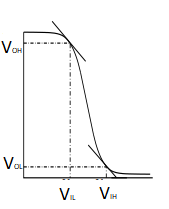VIH 5VDD + 3VTN + 5VTP VOL VDD - VTN + VrP and
Verify Eq

Consider a simple CMOS inverter:

The pull-up network is equivalent to pMOS and the pull-down network is equivalent to nMOS of the inverter.
Considering nMOS=off and pMOS=on, then the inverter transfer characteristic is:

Here, input voltage
The n channel is OFF and the p channel is ON and the output voltage, VO = VDD
When nMOS is saturated and pMOS is Linear:
Both transistors are ON, the input voltage is
and the output voltage is such that the currents through both the transistors are equal.
The output voltage is given by:
for
Now, when the input voltage is
then both the transistor are saturated.
The range of output voltage is given by:
If the input voltage is further increased then nMOS becomes linear and pMOS is saturated. Then the range of input voltage is:
The current in this condition is:
The quadratic equation we get from this is:
The solution to this equation is:
When
Step by step
Solved in 3 steps with 2 images









